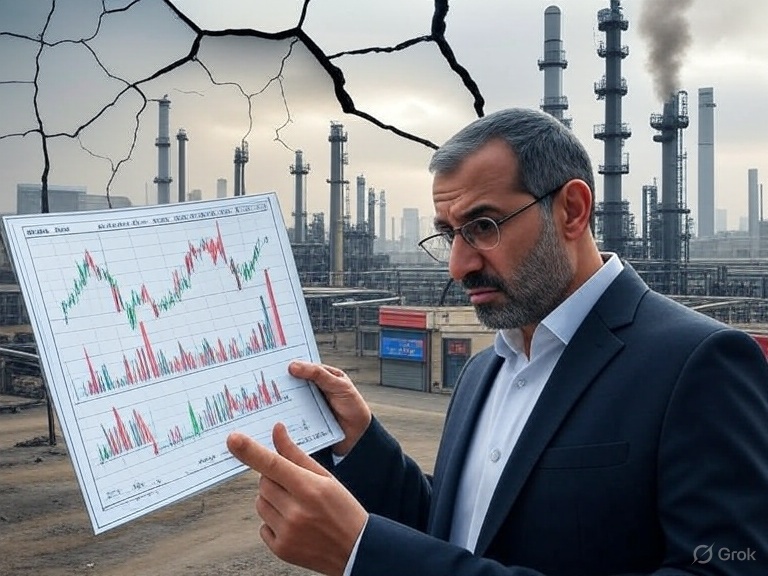How the Iran-Israel War Impacts Iran's Economy and the Middle East: A Comprehensive Analysis
Monday 23 Jun 2025As missiles fly and tensions soar, the Iran-Israel war is reshaping the economic landscape of Iran and the broader Middle East. From crippled infrastructure to skyrocketing oil prices, the conflict’s ripple effects are felt globally. What does this mean for Iran’s struggling economy, and how will the region navigate this crisis? Dive into our in-depth analysis to find out.

Impact of the Iran-Israel War on Iran’s Economy
1. Infrastructure Destruction and Soaring Reconstruction Costs
Israel’s “Operation Roaring Lion” in June 2025 targeted Iran’s nuclear facilities, military bases, and critical infrastructure, including oil refineries and power grids, inflicting severe damage.
Impacts:
Destroyed air defense systems and radars have spiked Iran’s defense spending.
Damaged oil facilities have disrupted production and exports, slashing foreign currency revenues.
Reconstruction costs, estimated in billions, strain Iran’s budget amid Iran sanctions limiting access to global financing.
2. Rampant Inflation and Worsening Living Standards
The war, coupled with tightened sanctions, has driven Iran inflation to unprecedented levels, squeezing households.
Consequences:
The rial’s value has plummeted due to dwindling oil revenues and rising military costs.
3. Disrupted Oil and Gas Exports
As a major OPEC producer, Iran faces significant setbacks in its oil and gas exports, a lifeline for its economy.
Effects:
Attacks on oil infrastructure and threats to the Strait of Hormuz have curtailed exports to key buyers like China.
Reduced oil revenues have widened Iran’s budget deficit, limiting funding for war efforts and development.
The loss of market share in global oil trade weakens Iran’s long-term economic leverage.
4. Deepening Sanctions and Economic Isolation
Iran’s threats to exit the Non-Proliferation Treaty (NPT) and ongoing military actions have triggered fresh Western sanctions, further isolating its economy.
Outcomes:
Banking restrictions have cut Iran off from SWIFT and global markets, stifling trade and investment.
Foreign investment has dried up, halting industrial and energy projects.
Iran is pivoting toward non-Western economies like China and Russia.
Impact on the Middle East’s Economy
The Iran-Israel war is reverberating across the Middle East, disrupting trade, energy markets, and regional stability.
1. Surging Oil and Energy Prices
Disruptions in Iran’s oil exports and threats to the Strait of Hormuz have driven global oil prices upward.
Consequences:
Oil exporters like Saudi Arabia and Qatar benefit temporarily, but volatility threatens long-term planning.
Higher fuel costs are stoking inflation in energy-importing nations like Turkey and Jordan, hurting consumers.
Analysts predict oil prices could surpass $100 per barrel, boosting Russia’s revenues but straining Western economies.
2. Trade and Supply Chain Disruptions
The war has upended regional trade routes and supply chains, raising costs for goods and services.
Consequences:
Houthi attacks on commercial shipping in the Red Sea have inflated shipping and logistics costs.
Gulf countries like the UAE and Saudi Arabia face declining maritime trade volumes due to heightened risks.
Regional trade initiatives, such as the IMEC corridor, are stalled, hampering economic integration.
3. Declining Investment and Heightened Geopolitical Risks
The conflict has made investors wary, increasing the risk premium for Middle East investments.
Outcomes:
Non-oil-dependent economies like Lebanon and Jordan are seeing tourism and investment plummet.
Even wealthy nations face setbacks, with Saudi Arabia’s Vision 2030 program at risk amid fears of escalation.
Uncertainty is deterring long-term capital inflows, slowing regional development.
4. Rise of Non-Western Economic Influence
The war disrupts Western dominance, creating opportunities for non-Western powers.
Effects:
China, Iran’s top oil buyer, benefits from discounted oil supplies, strengthening its regional foothold.
Russia gains from higher oil prices, bolstering its economic and geopolitical clout.
These shifts are tilting the Middle East’s economic balance toward non-Western powers.
Future Scenarios and Economic Outlook
1. Scenario: Prolonged Conflict
Iran: Persistent war will deepen Iran’s economic crisis, with soaring inflation and shrinking GDP. Social unrest could intensify.
Middle East: Higher oil prices may benefit producers short-term, but importers face recession risks.
2. Scenario: Ceasefire
Iran: A temporary truce could ease economic pressure, enabling limited reconstruction, though sanctions will cap recovery.
Middle East: Reduced tensions would revive trade and tourism, stabilizing markets.
Strategies to Mitigate Economic Impacts
For Iran:
Pursue regional diplomacy to secure a ceasefire and ease sanctions.
Diversify the economy to reduce oil dependency.
Strengthen ties with non-Western powers for investment and technology.
For the Middle East:
Enhance GCC economic cooperation to buffer war impacts.
Invest in renewables to lessen oil reliance.
Support mediation by neutral states like Qatar or Oman.
Conclusion
The Iran-Israel war is wreaking havoc on Iran’s economy, with devastated infrastructure, crippling inflation, and slashed oil exports. The Middle East economy faces surging energy costs, disrupted trade, and waning investment. Diplomacy, economic diversification, and regional collaboration are critical to mitigate the fallout. As the conflict evolves, staying informed through trusted sources is essential for navigating this turbulent landscape.
